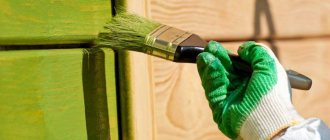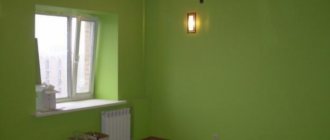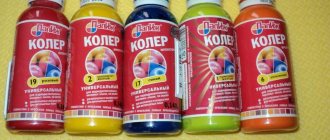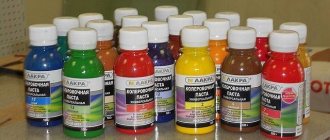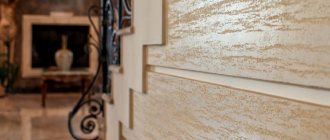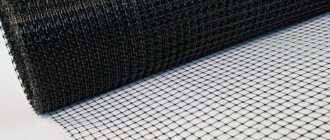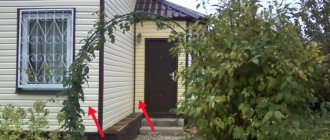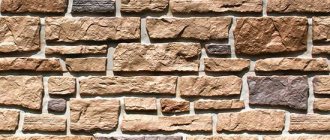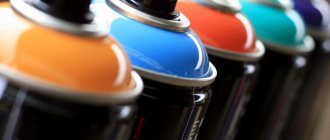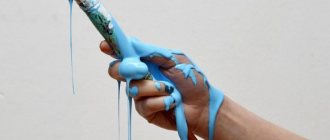Facade paint is a facing coating that protects walls from mechanical damage and external atmospheric influences, and gives the building decor and original design.
Facade painting materials must meet increased requirements for strength, color fastness, and moisture resistance.
In addition, paints for cladding the external surface of walls must combine not only quality indicators, but also last as long as possible.
In this article we will answer the question of what paint is best to paint the facade of a private house.
No. 1. Types of paints for facade work
Common sense dictates that facade paint should have the following properties:
- resistance to ultraviolet radiation;
- resistance to moisture;
- resistance to temperature changes;
- resistance to aggressive chemicals, especially if the house is located near a busy highway or in an industrial area;
- antiseptic properties;
- high decorative qualities.
Naturally, not every existing paint will withstand intense street conditions - specific performance qualities are determined by its composition, in which the binder plays the most important role . After drying or evaporation of the solvent, the binder forms a film with protective characteristics and high adhesion to the base.
Based on the type of solvent, paints are divided into two groups:
- on organic solvents , incl. based on white spirit, they form a dense weather-resistant film, but are somewhat toxic and fire hazardous;
- water-soluble paints are more environmentally friendly, since water is used instead of toxic organics.
Depending on the type of binder, paints are:
- on synthetic resins (acrylic, silicone, vinyl);
- based on mineral substances (cement, lime, liquid glass).
The amount of binders is an indicator of paint quality . The cheapest materials contain few binders, and instead the bulk is occupied by fillers, which do not in any way affect the quality of the finished coating. It is not easy to check the amount of filler in paint - the manufacturer must notify about this, and the reliability of this information depends on the name of the company.
Teknos Nordica Eco
This is an acrylic water-based paint made in Finland. The brand has existed for over 70 years.
Used for finishing painting of wooden surfaces.
Characterized by the following parameters:
- abrasion resistance;
- resistance to UV and temperature fluctuations;
- has no smell;
- diluted with ordinary water;
- quickly clings to the surface;
- Touch dry time 20 minutes;
- can be applied in any way;
- preservation of operational qualities for 15-20 years;
- pollution does not stick;
- The coating is easy to clean from dirt.
Teknos Nordica Eko
Objectively one of the best options for wooden facades. Although alkyd paint for wood is also considered an excellent solution.
But the price is high. About 850 rubles per 1 liter.
No. 2. Synthetic resin paints
Acrylic, vinyl and silicone paints are usually water-based, and the result is an environmentally friendly and completely non-toxic coating. Much less common, but still found on sale, are organosoluble options.
Vinyl paints
Polyvinyl acetate or vinyl acetate copolymers are used as a binder. The main advantage is low price , but in terms of vapor permeability, resistance to moisture, resistance to chemical contamination and color fastness, vinyl paints are inferior to acrylic paints, which is why they have recently been used less and less for finishing facades.
Acrylic paints
Among water-emulsion ones they are the most popular . They are resistant to various atmospheric influences, moisture, ultraviolet radiation, “breathe” and are durable for 10-15 years or more. Other advantages include the ability to dry quickly and low price. Acrylic paints are alkali-resistant and have good adhesion to many substrates. Thanks to tinting, you can get absolutely any desired color. The coating is suitable for painting concrete surfaces and facades made of cement-sand plaster, and no preliminary priming is required. Not suitable for silicate and lime facades.
Silicone paints
Silicone paints are made on the basis of silicone resins and have excellent hydrophobic properties , they do not soften under the influence of high temperatures, have a neutral electrical charge, so they almost do not attract dust and dirt, which ensures long-term preservation of the original appearance of the facade . Silicone paints are resistant to sunlight, mechanical stress, durable, elastic , biologically stable, and resistant to fading and are available in a variety of colors. Silicone paints are suitable for almost all substrates: concrete, cement-fiber boards, as well as cement, lime and cement-lime plasters. The only downside is the cost .
Acrylic-silicone paints
It is not difficult to guess that the composition of such paints includes acrylic and silicone resins, so the coating has the advantages of the two paints described above. They are resistant to moisture, have high moisture permeability, are resistant to abrasion, and practically do not get dirty.
Oil paints , produced on the basis of natural or artificial drying oils, have recently been used less and less for facade decoration, as they take a long time to dry, have a specific smell and quickly fade. However, due to its low price, the coating is still used for painting wooden facades.
Tikkurila Pika Teho
One of the best paints in the world for wood processing. The base is natural oil. Dries quickly. Produced in Finland.
Let's highlight several features:
- creates thick. protective and elastic layer on wood;
- withstands any temperature changes;
- does not crack and does not delaminate;
- consists of acrylate and natural oils;
- there is almost no smell;
- drying takes 2-4 hours;
- durability of the coating (about 20 years);
- UV resistance;
- consumption 1 l per 4-8 m2;
- used for preliminary priming of the surface.
Tikkurila Pika Teho
This paint will cost 600 rubles per 1 liter.
No. 3. Mineral paints for facades
Mineral paints include lime, cement and silicate paints.
Lime paint
Lime paints are made from slaked lime. These can be ready-to-apply coatings or pastes that are diluted with water and pigment directly at the construction site. The pigment must be resistant to alkaline conditions, which significantly limits the possible color palette, but this is not the only drawback of lime paint for facades. It has low resistance to moisture, low durability, gets dirty relatively quickly and can be washed off by heavy rain.
The advantages of the material include low cost, high vapor permeability and excellent antiseptic properties . Today, coating is used less and less, but in some cases it is irreplaceable. Lime paint is still used for the restoration of architectural monuments.
Cement paint
Cement paints are produced in the form of powders, which are diluted on site with water or special preparations. The paint base is white or colored Portland cement, to which slaked lime (about 15%) is added to improve water-holding capacity and water-repellent agents (about 1%) to increase resistance to weathering. Such coatings have high vapor permeability, are inexpensive , and can withstand exposure to sunlight, but are not very resistant to moisture and tend to peel off.
Silicate paint
Silicate paints are produced on the basis of potassium liquid glass with the addition of ethyl silicate. The composition is resistant to sunlight, temperature changes, aggressive atmospheric influences (acid rain), has biological resistance , and due to the presence of water repellents in the composition, resistance to moisture is added to the advantages. The color palette of silicate paints is limited; they cannot be used over acrylic and silicone paints, and work must be performed in personal protective equipment.
Polysilicon paints
Polysilicon paints are also called silicate-ash paints . In fact, this is a more advanced analogue of silicate paint. The coating is resistant to moisture, vapor permeable, suitable for painting facades plastered with cement and cement-lime compositions.
Comparison table of characteristics
The table below presents the main characteristics of the brands in question. By comparing them with each other, it will be much easier for you to choose a paint that meets your wishes and requirements.
| Paint name | Manufacturer country | Characteristics | Volume, in l |
| Super Star Multi Facade | Ukraine | suitable for interiors and facades, environmentally friendly, high vapor permeability | 14 |
| Facade Lux | Russia | matte paint, suitable for painting brick exterior surfaces | 30 |
| Ceresit CT 44 | Russia | environmental friendliness, safety, acrylic type | 15 |
| Triora SPAIN active | Ukraine | waterproof, matte, strong and durable | 10 |
| Baumit NanoporColor | France | self-cleaning formula, long lasting, easy to apply | 14 |
| Element Pro Relief | Ukraine | acrylic decorative paint, matte, water-repellent | 16 |
| Element 8 | Germany | high diffusion abilities, moisture resistance and protection from external influences | 1 |
No. 4. Facade paint and base type
The manufacturer, as a rule, indicates on the packaging what type of surface a particular material is intended for. To make your choice easier, we present the so-called. ideal base-paint pairs:
- For cement and cement-lime plasters, vinyl, silicone, acrylic, acrylic-silicone, cement, lime, silicate and polysilicon paints are suitable. In general, almost everything;
- For silicate plasters , as well as for facades previously painted with silicate paints , silicate, lime, cement and polysilicon paints are suitable, which can be applied even without a primer. If you complicate your task a little and pre-prime the surface, you can also use vinyl, acrylic, acrylic-silicone and silicone paints;
- facades made with lime plasters , as well as painted with lime paints , can be finished with lime, silicate, cement and polysilicon paints. Some silicone paints, which have a high carbon dioxide permeability, are also suitable;
- if organic plasters , then it is best to use silicone, acrylic and polysilicon paints;
- the concrete base can be painted with acrylic, silicone, silicate and polysilicon paints;
- Brick facades are rarely painted, but if the need arises, you can use a range of suitable paints. Silicone, acrylic, acrylic-silicone paints, as well as silicate, cement and lime compositions are suitable for ceramic To paint sand-lime bricks, you can use polysilicon, cement and silicate compounds;
- compositions with high anti-corrosion properties are suitable for metal
- for coloring wooden facades It is better to take acrylic or alkyd enamel, acrylic-based primer or colorless varnishes that will protect the wood and emphasize its natural beauty.
No. 5. What paint properties should you pay attention to?
Despite the fact that façade paints have requirements for resistance to moisture, sunlight, mold, mildew, abrasion and other factors, these properties are expressed differently in different compositions. When choosing facade paint, you need to pay attention to the following properties:
- waterproof . One of the main requirements for facade paint is the ability to withstand exposure to atmospheric moisture and not absorb it. Otherwise, the finishing layer will become dirty, affected by fungus, lose integrity and even fall off. The manufacturer must indicate on the packaging the water absorption coefficient w , which ideally should not be higher than 0.05 kg/(m²•h0.5). Sometimes percentages are also given. The lower this indicator, the better;
- the vapor permeability of paint indicates its ability to transmit moisture leaving the house, and it is this indicator that determines how healthy the microclimate in the room will be. If the walls of the house are made of vapor-permeable material, and the paint has low vapor permeability, then moisture will condense inside the wall, which will not lead to anything good. You should definitely look for information on vapor permeability on the paint packaging. It is defined in different ways. It can be indicated as the amount of water that passes through 1 m2 of painted surface per day. For vapor-permeable paints, this value starts from 130 g/m2 per day. Sometimes vapor permeability is indicated using the Sd coefficient, which means the thickness of an air layer with the same vapor permeability as a layer of facade paint. The lower this indicator, the better, and ideally it should be at the level of 0.05-0.11 m. Much less often, vapor permeability is determined through the coefficient of diffusion resistance , which for good “breathable” paints approaches 1400-1500;
- resistance to ultraviolet radiation is not measured by any indicators, but if the region is southern and sunny, then it is better to take polysilicon, acrylic-silicone and acrylic paints - they are the most resistant to sunlight and retain their original color for a long time;
- abrasion resistance - an indicator that largely determines the durability of the coating and the preservation of its original appearance. During operation, the facade will need to be washed, which will certainly lead to abrasion. Moreover, some places of the facade, in particular near the front door, will be subject to increased loads. To prevent the paint from wearing off and losing its color after a couple of years, pay attention to number of dry and wet cleaning cycles. A responsible manufacturer always indicates this information on the packaging, and an indicator of 5000 cycles will be quite sufficient;
- the ability of paint to get dirty and self-clean . It often happens that a painted facade, just a couple of months after painting, acquires a grayish tint, this is especially typical for areas located near roads and industrial enterprises. Let us immediately note that there are no paints that do not get dirty at all, but there are compositions into which dirt is not absorbed, i.e. does not penetrate its structure, and dust is easily washed off from the surface layer even during rain. This is called the ability of paint to self-clean . Hydrophobic properties begin to reveal themselves in full 3-4 weeks after applying the paint. Silicone paints, as well as acrylic and silicate compositions, perform best in this regard. Don’t forget about the tricks: dirt is washed off much better from a glossy surface, and it is less noticeable against a dark background;
- resistance to fungus. Houses built near water, in areas with high levels of groundwater, as well as buildings located in dense shade, are most susceptible to mold development. The easiest way to avoid its appearance is to use lime paints, which have excellent antiseptic properties, but this is far from a universal option, and they cannot boast of a wide palette of colors. An alternative to them is bioprotective compositions based on acrylic. Another solution is to apply antiseptic primers to the base, after which you can use any paint;
- The manufacturer must honestly indicate paint consumption It is approximately 5-12 l/m2 and depends not only on the type of paint, but also on the characteristics of the base, incl. absorbent properties and surface type. Paint consumption will be less when processing smooth surfaces. If the paint is applied in two layers, then the indicated consumption is multiplied by two and another 10-15% of the reserve is added;
- The drying time for different compositions differs, and the packaging indicates the time after which a second coat of paint can be applied (this is about 2-5 hours) and the time after which the paint fully acquires all its performance qualities.
No. 6. Textured paint for facade
Textured facade paints differ from ordinary ones in their granular consistency , thanks to which it is possible to form a relief surface. Such compositions are also called structural and texture paints, but they always mean the same thing - acrylic paint, which includes granular granules. Less often, another base can be used instead of acrylic.
Textured paint is applied to the facade in a fairly thick layer, about 10 mm, so its consumption is higher than compositions that form a smooth surface. This is more than compensated for by the composition’s ability to hide cracks and chips on the wall surface, so there is no need for preliminary preparation and careful leveling. The resulting texture resembles decorative plaster, but the pattern largely depends not on the composition of the paint, but on the method of its application and the tools used.
No. 7. Choosing the color of facade paint
To make your house happy just by looking at it, you need to choose the right color for the façade paint. It is important that the shade is in harmony with the environment, neighboring buildings, the color of the roof, windows, doors and stairs. Manufacturers, as luck would have it, offer such a wide range of shades that it is very easy to get confused. When it seems that you can’t do without the help of a professional, use the simple rules that specialists use in their practice:
- It is best to use natural colors in decoration;
- the color of the facade should be lighter than the color of the roof . Opposite combinations do exist, but choosing the appropriate combination will most likely require designer intervention;
- it is better to paint a house with a bright roof in light shades;
- When decorating the facade, it is better to use not one, but 2-3 shades that combine with each other . One can be the main one, and the second will emphasize window and door openings and interesting architectural elements. Using more than three colors is not recommended;
- buildings located in warm regions, it is better to paint it in light shades so that the room is not so hot in summer;
- It is better to evaluate the paint color not from a catalogue, not on the pages of an online store, and not even in the store itself, looking in a jar. To understand how the color will look in real conditions, it is better to go out with a can of paint, or even better, apply it to the most inconspicuous part of the facade in order to make a final decision;
- If you don’t know what shade to choose, choose pastel colors;
- a painted house must be in harmony with the surrounding landscape, and this applies not only to nature, but also to existing buildings nearby, so even the color of the facade of neighboring houses will have to be taken into account, otherwise your home will fall out of the overall context;
- for houses with complex configurations, it is better not to use bright colors;
- For buildings located in the sun, matte paints - glossy ones will give too much glare.
The range of different shades is large, and taking into account the possibility of tinting some compositions, it is generally endless.
No. 8. Manufacturers of facade paints
The quality of the paint and the compliance of its actual properties with the declared ones largely depends on the name of the manufacturer. On store shelves you can find products from dozens of companies, both foreign and domestic. Some of the largest and most reputable manufacturers are:
- Tikkurila is a large Finnish manufacturer that does not need any special introduction. The range includes paints intended for painting wooden and stone facades, metal surfaces, and concrete plinths. Silicone, silicate, lime and acrylic compositions are presented, the quality is exemplary;
- Dulux is one of the world's largest coatings companies. Factories are located in 26 countries. For exterior use, paints with matte, glossy and textured surfaces are available. All compositions have antiseptic properties, their warranty is 15 years;
- Dufa is a large German company operating since 1955. Produces paints for any occasion, for any surface and conditions of use. Water-dispersion compositions are produced for facades; there are especially strong and especially elastic compositions;
- Marshall is a Turkish company, which today is part of the world's largest concern AkzoNobel. The products are in great demand on the domestic market, and a network of sales points has been developed. For the facade, only acrylic paint is available, which can be tinted in any shade;
- Caparol offers perhaps the largest selection of facade paints. The assortment includes mineral and dispersion based paints, paints intended for concrete, cement and lime plasters;
- Eurolux is a domestic manufacturer, whose products are much cheaper than their foreign counterparts, but at the same time not much inferior to them in quality. For facades there is acrylic and latex paint;
- "Optimist" - another domestic manufacturer offering a decent range of facade paints, incl. silicone, acrylic and latex. The quality is good, the price is affordable;
- OLIMP paints are produced by . The products fully meet all international requirements and can easily compete with foreign analogues. Matte acrylic paint is available for the facade, which can be tinted in any color.
It is better not to skimp on facade paint - not only the appearance of the house depends on it, but also in many respects its durability and strength.
The article was written for the site.
Tags: Facade, Enamels and paints
VGT VDAK 1180
Domestic economy class product. Has a wide range of applications.
In 2013, paints from this manufacturer were used in the construction of the Fisht stadium (Sochi).
Characterized by the following features:
- affordable price;
- adequate level of quality;
- suitable for external and internal work;
- clings well to concrete, brick, plaster, as well as fiberboard, plasterboard and even wallpaper;
- work should be carried out at a temperature not lower than -10 degrees Celsius;
- long service life of the coating;
- The dye allows you to choose any desired color and shade.
Paint VGT VDAK 1180
At the same time, consider where you buy the paint. The quality may vary greatly from this.
A container with a volume of 7 kg will cost 600 rubles.
